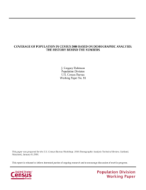Coverage of Population in Census 2000 Based on Demographic Analysis: The History Behind the Numbers
Coverage of Population in Census 2000 Based on Demographic Analysis: The History Behind the Numbers
Issues
- The accuracy of the historical estimates of net international migration up to 2000
- Achieving consistency of the reporting of race in the Demographic Analysis (DA) estimates with reporting of race in the census
- The assumptions regarding birth registration completeness (including the assumption that complete coverage started in 1985)
- How to measure uncertainty in the DA estimates
This paper describes the development and the history of the Demographic Analysis estimates used for the evaluation of coverage in 2000. The first section gives an overview of the demographic technique and describes the components of population changes used to construct the DA estimates. The second section addresses the individual components used to construct the DA estimates. A third section reviews the limitation of the DA method and how revisions affect the estimates over time. A final section provides a summary.
Introduction
In the United States, Demographic Analysis (DA) methods have a long history of measuring population coverage trends between censuses and differences in coverage by age, sex, and race (Black, non-Black) at the national level. Demographic Analysis is an analytic approach that has been used to measure coverage of the national population in every census since 1950 (see Coale, 1955; Siegel and Zelnik, 1966; U.S. Bureau of the Census, 1974, 1988a; and Robinson et al., 1993 for the demographic evaluations of the 1950-1990 censuses). DA has documented the long-term reduction in the census net undercount rate, yet DA also reveals the persistent and disproportionate undercount of certain demographic groups (such as adult Black men—see Figure 1). The race, age, and sex patterns of net undercount rates in 2000 mirrored that of recent censuses—higher net undercount rates of adult males than females (especially for Blacks), disproportionate net undercount rates for young children, net overcounts of older children and teenagers, and net overcounts for some older age groups (see Figure 2).
Demographic Analysis estimates serve two principal purposes in census evaluation:
1) DA estimates provide benchmarks to assess completeness of coverage in the current census and document changes in coverage from previous censuses. The national DA estimates have become the benchmark for tracking historical trends in net census undercounts and for assessing coverage differences by age, sex, and race.
2) The independence and internal consistency of the DA estimation process allows the use of the estimates to check survey-based coverage estimates; in particular, we can assess the consistency of the age-sex results. DA and the survey-based method use entirely different methodologies. Because the sources and patterns of errors in the two estimates are sufficiently different, any disagreement in the results is important to understand. The comparison of the DA and survey-based estimates became critical in the assessment of coverage of Census 2000. The wide difference between the initial DA estimate of population and the survey estimates (called the Accuracy and Coverage Evaluation, or A.C.E.) was a major factor in the Census Bureau’s recommendation not to adjust the census for coverage error (U.S. Bureau of the Census, 2001c).
Others in Series
Working Paper
Working Paper
Working Paper




